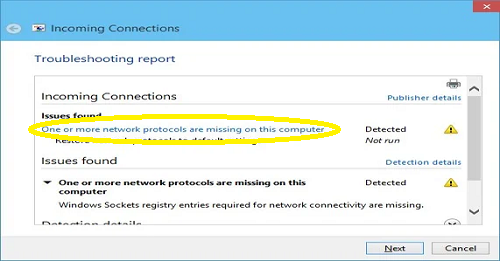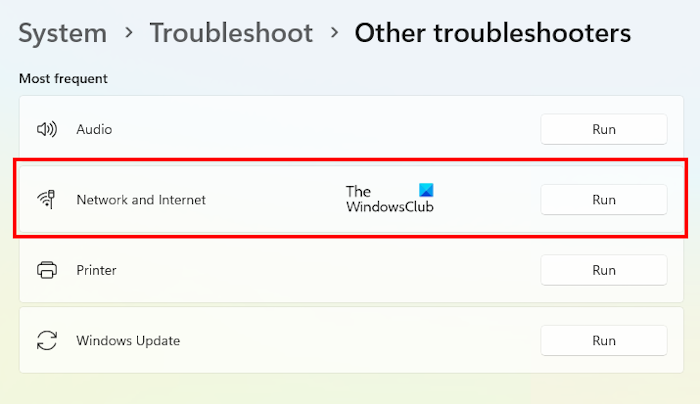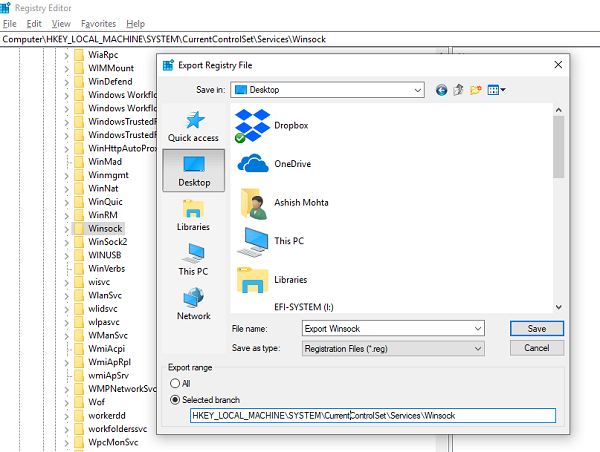Network Protocols are a set of rules or standards used by Windows to communicate over the internet. They make sure the data is sent correctly across between computers, but if any of the Network Protocol is missing in Windows 11/10, things go south. You might not be able to browse the internet, share files. If the word protocol is still not clear, some examples are TCP, LLDP, etc.
One or more Network Protocols are missing on this computer

If after you run the Incoming Connections Troubleshooter, you receive any error which has a “Network Protocol is missing” message, below is a list of troubleshooting tips to use. You will need admin privileges to execute the commands.
Use the following fixes to resolve the issue:
- Run appropriate troubleshooter(s)
- Reinstall Network Adapter & Reset networking component
- Diagnose Network Adapter
- Reset Winsock & TCP/IP
- Disable and re-enable your network adapter
- Import Winsock settings from another computer
Let’s see all these fixes in detail.
1] Run Network troubleshooters
Windows 11/10 has multiple troubleshooters. You can run appropriate network troubleshooters which solve most of the problems related to the network. See if running these troubleshooters helps you fix the issue.

Do note that Microsoft has deprecated MSDT-based troubleshooters in Windows 11 version 22H2 and later. Hence, if you use Windows 11 version 22H2, you can run the Network and Internet Troubleshooter. The devices with Windows 10/8/7 and Windows 11 versions earlier than 22H2 are not affected by this update.
2] Reinstall Network Adapter & Reset networking component
Sometimes corrupted drivers cause issues, and the best way to go ahead is to reinstall the network adapter. Open Device Manager, find your adapter and then follow the instructions to reinstall and reset network adapters.
3] Diagnose Network Adapter
Go to Control Panel > All Control Panel Items > Network Connections and find the network adapter which might be causing the problem. If you are using WiFi, then it’s your WiFi adapter, else it’s your Ethernet adapter. Right-click and select diagnose to troubleshoot.
4] Reset Winsock & TCP/IP
Windows Sockets or Winsock is like socket which was initially designed to add support for IPv4 to Windows. Later this evolved to support more protocol. It is possible to Reset Winsock with the following command “netsh winsock reset.” Open the Command Prompt with admin privileges, and then execute the command.
You may want to also Reset TCP/IP.
5] Disable and re-enable your network adapter
If the problem still persists, disable and re-enable your network adapter via the Device Manager. First, disable IPv6, then disable your network adapter. To disable IPv6, you have to open your network properties. Wait for a few minutes and then enable the Network adapter again. Affter that, perform winsock reset. When the process gets completed, shut down your computer properly and wait for a few minutes. Now, turn on your PC. This should fix the issue.
6] Import Winsock settings from another computer

If the reset Winsock attempt doesn’t work, you can import settings from a computer on which there is no network protocol error. To get this done, you will have to access the registry, and then export and import few settings. So make sure you know how to handle registry.
Type regedit in the Command Prompt and hit enter.
In the registry hive, navigate to HKEY_LOCAL_MACHINE\SYSTEM\CurrentControlSet\Services
Find two keys (they look like folders) with name Winsock and Winsock2. Right-click on each of them, and select Export.
Copy the registry keys to a USB drive. Next, copy the keys on the PC where the network protocol issue exists.
Now double-click on each of them, and it will install the WINSOCK keys.
What does one or more network protocols are missing from this computer?
The meaning of the error message “One or more network protocols are missing from this computer” is self-explanatory. This error means that one or more network protocols required to connect your computer to the network are missing. This can happen due to a variety of reasons like misconfigured network configuration, corrupted network driver, etc.
How to fix network problem with CMD?
To fix network problems with CMD, you can execute different commands. You can flush the DNS cache by using the Command Prompt. Flushing the DNS cache is helpful in resolving network issues. In addition to this, you can also perform a Winsock reset via the Command Prompt to fix network issues.
We also recommend you to check out detailed guide of Network troubleshooting in Windows 11/10. It has a list of all possible commands that you can use to fix networking issues in Windows 11/10.